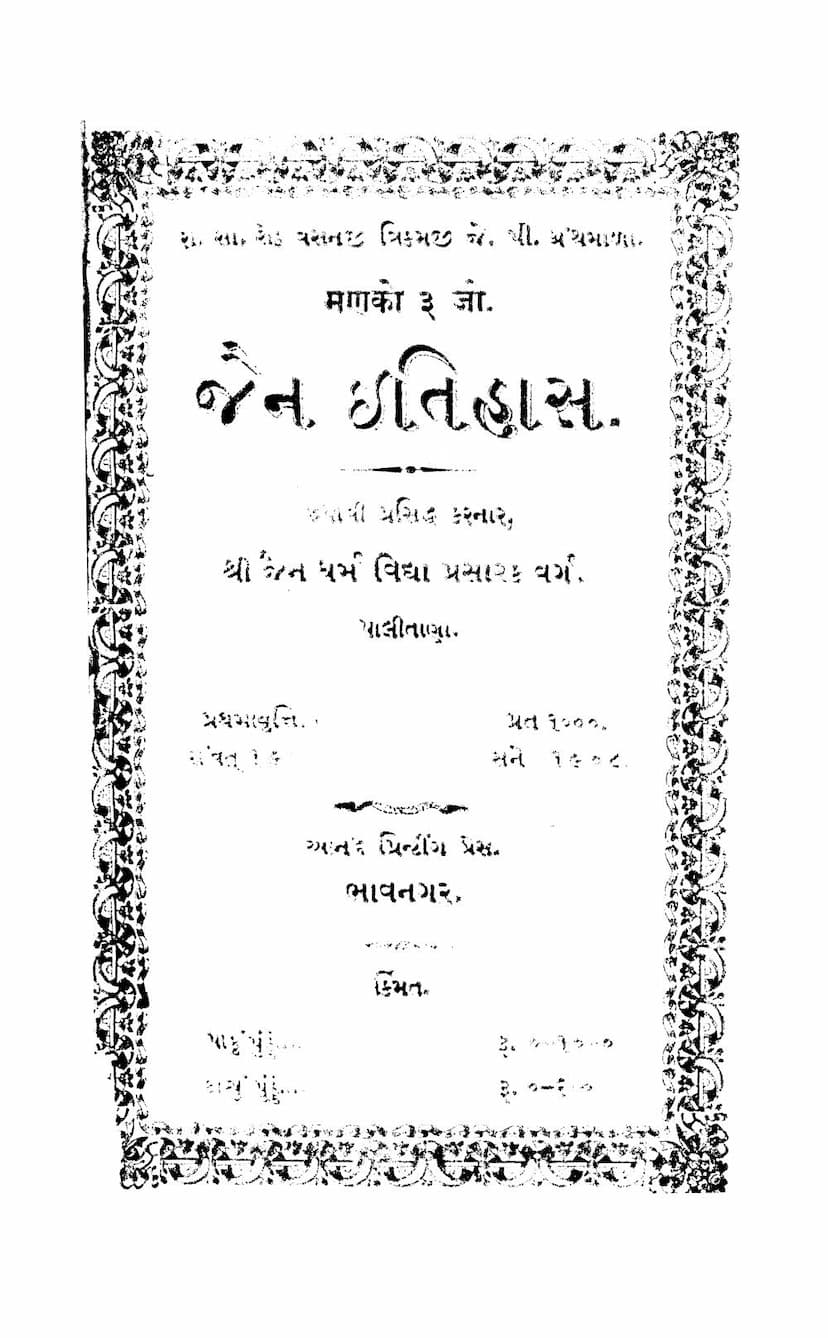Jain Itihas
Added to library: September 2, 2025

Summary
Here's a comprehensive summary of the Jain text "Jain Itihas" by Jain Dharm Vidya Prasarak Varg, based on the provided pages:
Book Title: Jain Itihas (History of Jainism) Author/Publisher: Jain Dharm Vidya Prasarak Varg, Palitana Catalog Link: https://jainqq.org/explore/007286/1
This book, "Jain Itihas," aims to provide a detailed historical account of Jainism. It begins by emphasizing the importance of history for understanding religious and social practices, highlighting that Jainism's influence on India is profound and its core principles, though colored by time and place, remain consistent. The text states that Jain history starts from ancient times, as evidenced by their authentic scriptures (Agams). It asserts that Jainism possesses a wealth of material for historical exposition, arguably more than any other religion.
The history of Jainism, according to the book, begins with the time of the Yugaliya humans and traces the contributions of its progenitors and scholars. It highlights how Jain history is a testament to the religious activities undertaken by Tirthankaras and Acharyas to attain spiritual knowledge and its fruits, reflecting their philosophies and lifestyles. Studying this history strengthens faith and clarifies the origins and evolution of Jain ethics and societal practices.
The book is structured into twenty-six chapters, commencing with the seventh Kulakar, King Nabhi, at the end of the third era of the current Avasarpini period. It provides a concise history from the first Tirthankara, Lord Rishabhdev, up to the twenty-third Tirthankara, Lord Parshvanath. It then details the period following the nirvana (liberation) of Lord Mahavir, the present era's propagator, and significant religious events of the Vir Samvat era.
Key Eras and Figures Covered (Chapter by Chapter Synopsis):
-
Chapter 1: Ancient History: Starts with King Nabhi and covers Tirthankaras from Lord Rishabhdev to Lord Parshvanath. It explains the origin of Jainism and the time of its establishment.
-
Chapters 2-5: Middle Period History: Covers figures from Sudharma Swami to Manak Muni, including the revival of the Dashavaikalik Sutra, and the origins of the Oshwal and Shrimali communities. It also touches upon the reigns of Nanda kings, Emperor Chandragupta, Chanakya, and ministers like Shakal.
-
Chapters 6-9: Early Modern Period History (Vikram Era): Details events from Vikram Samvat 1 to 17, including figures like Vachaswami, Aryasamit, and Vasusena Acharya, the liberation of Javada Shah, and the historical accounts of Aryarakshit Suri and Durbalika Pushpamitra Suri. It also mentions King Shiladitya, the destruction of Vallabhi, and the composition of the Shatrunjaya Mahatmya.
-
Chapters 10-26: Detailed Chronological History: The subsequent chapters delve into specific centuries and significant figures, including:
- Vikram Samvat 7th-9th Centuries: Aryas Sri Haribhadra Suri and Sri Siddh Suri.
- Vikram Samvat 10th Century: Acharya Sri Shilanga to Acharya Sri Virgani.
- Vikram Samvat 11th Century: Figures like Sri Sarvadev Suri, Dhanpal Mahakavi, and Shobhanacharya.
- Vikram Samvat 12th Century: Suraacharya, Vardhamanasuri, and Vimalshah.
- Later Chapters: Detail the lives of Jinshwar Suri, Abhaydev Suri, Vadivetala Shant Suri, the origins of Punmiyagachch and Vidhipakshgachch, Jayasingha Suri, the origin of the Lalana lineage, and Vadideva Suri.
- Subsequent Centuries: The history progresses through the 13th, 14th, 15th, and 16th centuries, covering prominent Acharyas like Devendrasuri, Jineshwar Suri, Dharmaghosha Suri, Somaprabha Suri, Jinprabodha Suri, Prabhaachandra Suri, Vajrasen Suri, Jinvallabha Suri, Jinadatta Suri, Dhanavijaya Vachak, Kakksuri, Devabhadra Suri, Hemachandra Suri, Yashovijaya Ji, and more.
- Specific Events and Concepts: The book also discusses significant events like the destruction of the Nanda kingdom, the rise of Chandragupta and Chanakya, the establishment of Anhilpur Patan, the origin of the Digambara sect, the conquest of Aidha, the destruction of Vallabhi, the composition of Shatrunjaya Mahatmya, the compilation of Jain scriptures, and the origins of various gacchas (sects or schools) like Punmiyagachch and Vidhipakshgachch.
- Key Figures and Their Contributions: The narrative highlights the efforts of scholars, rulers influenced by Jainism (like Kumarapala and Hemchandracharya), and the spread of Jain teachings through various Acharyas.
-
Chapter 26: Modern Period History (Vikram Samvat 1701-1964): This final chapter covers the period up to the present, mentioning figures like Moti Shah Seth, Sri Vijayanand Suri, Seth Premchand Raychand, Seth Keshavji Nayak, and Seth Narshi Natha, and their contributions. It also details the origin of the Dhundhiya sect.
Special Mentions and Themes:
- Dedication: The book is dedicated to Rao Saheb Shet Vasanji Trikamji J.P., acknowledging his significant contributions to Jain religious and educational activities, including his financial support for the publication of this series of books.
- Biographical Sketch: A significant portion of the book is dedicated to a detailed biography of the patron, Rao Saheb Shet Vasanji Trikamji, highlighting his philanthropic activities, business acumen, personal life challenges, and unwavering commitment to Jainism and education.
- Historical Significance: The text emphasizes that understanding Jain history is crucial for comprehending the transformation of Jain religious life, household practices, and customs. It reflects on the rise and fall of Jain institutions and the potential decline of virtues like enthusiasm, generosity, courage, and faith in the current era, urging readers to draw inspiration from the past.
- Call for Preservation: The authors express their long-held desire to publish such useful historical works and acknowledge the necessity of such publications for propagating knowledge among Jain brethren and preserving ancient Jain scriptures.
In essence, "Jain Itihas" is a comprehensive chronological account of the Jain tradition, tracing its lineage from the earliest times, highlighting the contributions of its Tirthankaras, Acharyas, scholars, and patrons, and illustrating the evolution of its practices and influence on society. The dedication and detailed biography of the patron underscore the importance of societal support in preserving and disseminating religious knowledge.